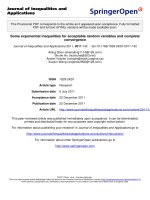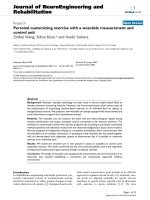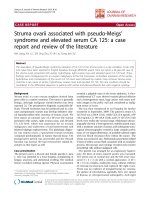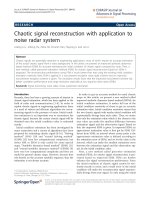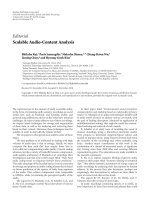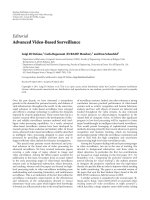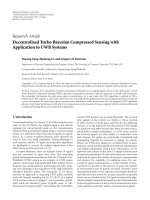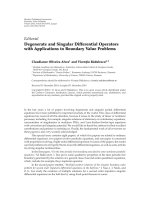Báo cáo hóa học: " Editorial Signal Processing with High Complexity: Prototyping and Industrial Design" docx
Bạn đang xem bản rút gọn của tài liệu. Xem và tải ngay bản đầy đủ của tài liệu tại đây (737.38 KB, 2 trang )
Hindawi Publishing Corporation
EURASIP Journal on Embedded Systems
Volume 2006, Article ID 90363, Pages 1–2
DOI 10.1155/ES/2006/90363
Editorial
Signal Processing with High Complexity: Prototyping and
Industrial Design
Markus Rupp,
1
Thomas Kaiser,
2
Jean-Francois Nezan,
3
and Gerhard Schmidt
4
1
Institute for Communication and RF Engineering, Vienna University of Technology, Gusshausstrasse 25/389, 1040 Vienna, Austria
2
Institut f
¨
ur Kommunikationstechnik, Leibniz Universit
¨
at Hannover, Appelstrasse 9a, 30167 Hannover, Germany
3
IETR/Image Group Lab, France
4
Harman/Becker Automotive Systems, 89077 Ulm, Germany
Received 10 July 2006; Accepted 11 July 2006
Copyright © 2006 Markus Rupp et al. This is an open access article distributed under the Creative Commons Attribution License,
which permits unrestricted use, distribution, and reproduction in any medium, provided the original work is properly cited.
Some modern applications require an extraordinary large
amount of complexity in signal processing algorithms. For
example, the 3rd generation of wireless cellular systems is ex-
pected to require 1000 times more complexity when com-
paredtoits2ndgenerationpredecessors,andfuture3GPP
standards will aim for even more number-crunching ap-
plications. Video and multimedia applications do not only
drive the complexity to new peaks in wired and wireless
systems but also in personal and home devices. Also in
acoustics, modern hearing aids, or algorithms for derever-
beration of rooms, blind source separation and multichan-
nel echo cancellation are complexity hungry. At the same
time the anticipated products also put on additional con-
straints like size and power consumption when mobile and
thus battery powered. Furthermore, due to new develop-
ments in electro-acoustic transducer design, it is possible
to design very small and effective loudspeakers. Unfortu-
nately, the linearity assumption does not hold any more
for this kind of loudspeakers, leading to computationally
demanding nonlinear cancellation and equalization algo-
rithms.
Since standard design techniques would either consume
too much time or not result in solutions satisfying all con-
straints, more efficient development techniques are required
to speed up this crucial phase. In general such developments
are rather expensive due to the required extraordinary high
complexity. Thus, de-risking of a future product based on
rapid prototyping is often an alternative approach. How-
ever, since prototyping would delay the development, it often
makes only sense when it is well embedded in the product de-
sign process. Rapid prototyping has thus evolved by applying
new design techniques more suitable to support a quick time
to market requirement.
This special issue focuses on new development meth-
ods for applications with high complexity in signal process-
ing and on showing the improved design obtained by such
methods. Examples of such methods are virtual prototyp-
ing, HW/SW partitioning, automatic design flows, float to
fix conversions, and automatic testing and verification.
We received seven submissions of which only four were
accepted.
In Rapid industrial prototyping and SoC design of 3G/4G
w ireless systems using an HLS methodology the authors Yuan-
bin Guo et al. present their industrial rapid prototyping ex-
periences on 3G/4G wireless systems using advanced signal
processing algorithms in MIMO-CDMA and MIMO-OFDM
systems. Advanced receiver algorithms suitable for imple-
mentation are proposed for synchronization, MIMO equal-
ization, and detection, VLSI-oriented complexity reduction
is presented. This design experience demonstrates that it is
possible to enable an extensive architectural analysis in a
short time frame using HLS methodology by abstracting the
hardware design iterations to an algorithmic C/C++ fixed-
point design, which in turn significantly shortens the time to
market for wireless systems.
In Generation of embedded hardware/software from sys-
temC the authors Salim Ouadjaout and Dominique Houzet
present a design flow to reduce the SoC design cost. This
design flow unifies hardware and software using a single
high level language and thus decreases the manual errors
by rewriting design code. It integrates hardware/software
(HW/SW) generation tools and an automatic interface syn-
thesis through a custom library of adapters. The approach is
validated on a hardware producer/consumer case study and
on the design of a given software-radio communication ap-
plication.
2 EURASIP Journal on Embedded Systems
In Efficient design methods for embedded communication
systems the authors Martin Holzer et al. analyze a complete
design process to exhibit inefficiencies. The lack of an inte-
grated design methodology is argued. High level character-
isation, virtual prototyping, automated hardware/software
partitioning, and floating-point to fixed-point data conver-
sion are bottlenecks to solve in such a methodology. For each
point, authors present and compare several tools and algo-
rithms leading to an efficient fast prototyping framework.
Examples are given in the field of high-complexity commu-
nication systems but can be extended to other complex ap-
plication fields.
In Fixed-point configurable hardware components the au-
thors Romuald Rocher et al. propose a flexible scheme for
fixed-point optimization in order to better exploit advances
in VLSI technology. After determining the dynamic range
and the binary point, a data word-length optimization fol-
lows by introducing a suitable user-defined cost function.
This central cost function, which, for example, depends on
chip area and/or energy consumption, is to be minimized
under the constraint of a pre-defined thresholded signal-to-
quantization noise ratio (SQNR). Through use of analytical
models the design time can be significantly reduced. A 128-
tap LMS filter design exemplarily explores the fixed-point
search space and demonstrates the benefits of the proposed
scheme.
Markus Rupp
Thomas Kaiser
Jean-Francois Nezan
Gerhard Schmidt
Markus Rupp received his Dipl Ing. de-
gree in 1988 at the University of Saar-
bruecken, Germany, and his Dr Ing. de-
gree in 1993 at the Technische Universi-
taet Darmstadt, Germany. He is presently
a Full Professor for digital signal process-
ing in mobile communications at the Tech-
nical University of Vienna. He is Associate
Editor of IEEE Transactions on Signal Pro-
cessing, EURASIP Journal of Applied Signal
Processing, EURASIP Journal on Embedded Systems and is elected
AdCom Member of EURASIP. He authored and co-authored more
than 200 papers and patents on adaptive filtering, wireless commu-
nications, and rapid prototyping.
Thomas Kaiser received the Ph.D. degree
in 1995 with distinction and the German
habilitation degree in 2000, both in elec-
trical engineering from Gerhard-Mercator-
University Duisburg. In the summer of 2005
he joined Stanford’s Smart Antenna Re-
search Group (SARG) as a Visiting Profes-
sor. Now he holds a chair on communica-
tion systems at the University of Hannover,
Germany, and is a founder of the spin-off
company mimoOn GmbH. He has published more than 100 pa-
pers and has co-edited four books on ultra-wideband and smart
antenna systems. He is the founding Editor-in-Chief of the IEEE
Signal Processing Society e-letter. His research interest focuses on
applied signal processing with emphasis on multi-antenna systems,
especially its applicability to ultra-wideband systems.
Jean-Francois Nezan is an Assistant Pro-
fessor at National Institute of Applied Sci-
ences of Rennes (INSA) and a member
of the IETR laboratory in Rennes. He re-
ceived his postgraduate certificate in sig-
nal, telecommunications, images, and radar
sciences from Rennes University in 1999,
and his engineering degree in electronic and
computer engineering from INSA-Rennes
Scientific and Technical University in 1999.
He received his Ph.D. degree in electronics in 2002 from the INSA.
His main research interests include image compression algorithms
and multi-DSP rapid prototyping.
Gerhard Schmidt received his Dipl Ing.
degree in 1996 and his Dr Ing. degree in
2001, both at Darmstadt University of Tech-
nology, Germany. Presently, he is work-
ing as a senior research engineer in the
acoustic signal processing group at Har-
man/Becker Automotive Systems in Ulm,
Germany. His main research interests in-
clude adaptive methods for speech and au-
dio processing.

